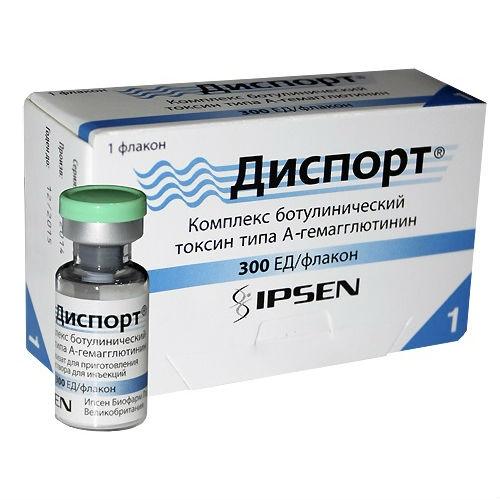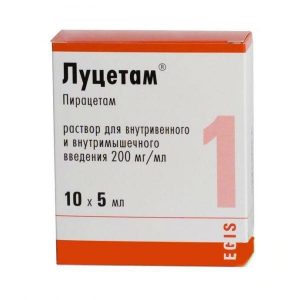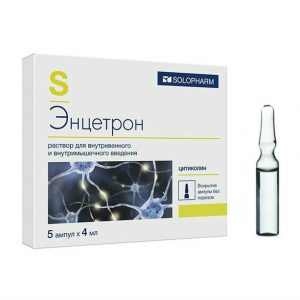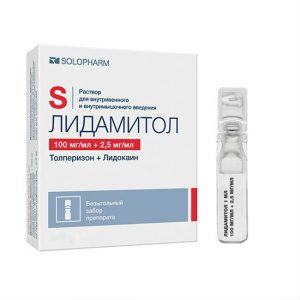Description
Release form
Lyophilisate for solution for intramuscular and subcutaneous administration
Packaging
1 vial
Pharmacological action
Dysport – muscle relaxant. The toxin Clostridium botulinum type A blocks the release of acetylcholine in the neuromuscular synapse, which leads to muscle relaxation in the area of drug administration. The recovery of neuromuscular transmission is gradual, as the formation of new nerve endings and restoration of contacts with the postsynaptic motor end plate.
The effect of the drug lasts for 3-4 months.
Indications
For use in adults: – blepharospasm
– hemifacial spasm
– spasmodic torticollis in adults
– muscle spasticity after a stroke
– hyperkinetic (facial) wrinkles.
For use in children over 2 years of age: – dynamic deformation of the foot caused by spasticity in cerebral palsy.
Contraindications
– pregnancy
– acute phase of concomitant diseases.
Special instructions
Treatment with Dysport should be carried out by a specialist who has experience in the diagnosis and treatment of these diseases and who have been trained on the route of administration of Dysport.
It should be borne in mind that electromyography is used for all complex forms of torticollis, with repeated administration of the drug, or in cases of treatment failure. Electromyography is indicated when the drug is injected into the deep muscles of overweight patients with weakly palpated muscles.
The main area of application of Dysport for cosmetic correction is the upper half of the face. The lower half of the face and neck are corrected by the introduction of botulinum toxin much less frequently. In these areas, it is preferable to use other methods.
With extreme caution, the drug should be re-administered to patients who have an allergic reaction to a previous injection. The risk of an allergic reaction should be considered when assessing the possible benefits of treatment.
With caution and under strict medical supervision, the drug is prescribed for patients with subclinical or clinical manifestations of neuromuscular transmission lesions, as the development of severe muscle weakness is possible.
In the acute stages of concomitant diseases, the drug is resumed after recovery.
There is currently no evidence of immune responses in the treatment of blepharospasm or hemifascial spasm. However, in some patients, the formation of anti-botulinum antibodies was observed in the treatment of spastic torticollis. Clinically, this was manifested by a decrease in the therapeutic effect, which required a constant increase in the doses of the drug.
To minimize the likelihood of occurrence and severity of side effects is possible by strictly adhering to the methods of administration of the drug Dysport and taking into account the anatomical and physiological characteristics of each individual patient.
The simultaneous use of the drug Dysport with antibiotics-aminoglycosides, as well as with drugs that increase the intracellular calcium concentration (aminopyridine, tetraethylammonium) is not recommended.
Influence on the ability to drive vehicles and control mechanisms
The question of the possibility of engaging in potentially hazardous activities, requiring increased attention and speed of psychomotor reactions, it should be decided only after evaluating the individual response of the patient.
Composition
active substance: botulinum toxin complex type A-hemagglutinin 300 IU
excipients: human albumin – 125 Ñg of lactose – 2.5 mg
Dosage and Administration
For adults and elderly patients, the total initial dose for treating bilateral blepharospasm is 120 units per eye.
The drug is administered subcutaneously in a volume of 0.1 ml (20 PIECES) medially, in a volume of 0.2 ml (40 PIECES) – laterally in the connection between the preseptal and orbital parts of both the lower and upper orbital muscles of each eye. For injections into the upper eyelid, the needle should be directed away from the center so as not to touch the muscle that lifts the upper eyelid.
The manifestation of the clinical effect can be expected within 2-4 days, the maximum therapeutic effect develops within 2 weeks.
For the prevention of relapse, the drug should be repeated every 8 weeks or depending on the clinical situation. With each subsequent administration, the dose should be reduced to 80 PIECES per eye (for example, 0.1 ml (20 PIECES) medially and 0.1 ml (20 PIECES) laterally above and below the eye according to the method described above). In the future, the dose of the drug can be reduced to 60 PIECES per eye, due to the exclusion of medially into the lower eyelid. Subsequent doses are determined depending on the effect obtained.
With unilateral blepharospasm, treatment is limited to the area of ??the affected eye. A similar treatment is carried out with hemifacial spasm.
Doses recommended for the treatment of torticollis are used in adults, having normal body weight and satisfactory development of the neck muscles. Reducing the dose of the drug is possible with severe weight loss or in the elderly, with reduced body weight.
The initial single dose for the treatment of spastic torticollis is 500 units, the drug is administered in parts in 2 or 3 of the most active muscles of the neck.
With a rotational crank, 500 units of the drug are administered as follows: 350 units in the head muscle of the head, ipsilateral to the direction of rotation of the head and 150 units in the sternocleidomastoid muscle, counter-laterally to the rotation.
In case of laterocollis (lateral crankshaft, tilt of the head to the shoulder), the drug at a dose of 350 PIECES is administered ipsilaterally into the muscle of the neck and at a dose of 150 PIECES is administered ipsilaterally into the sternocleidomastoid muscle. In cases accompanied by a raising of the shoulder due to the trapezius muscle or the muscle that raises the shoulder blade, treatment may be required in accordance with apparent muscle hypertrophy or according to electromyography.
With the introduction of the drug into 3 muscles, the dose of 500 PIECES is distributed as follows: 300 PIECES is introduced into the belt muscle, 100 PIECES into the sternocleidomastoid muscle, 100 PIECES into the third muscle.
With anterocollis (anterior crankshaft, tilting the head forward), 150 units are administered into both sternocleidomastoid muscles.
With a retrocollis (posterior crank, tilt of the head back), 250 units are introduced into each belt muscle of the head. Then, injections of the drug bilaterally into the trapezius muscles (250 units per muscle) may follow. If necessary, if there is no sufficient effect, repeat injections after 8 weeks.
Keep in mind that bilateral injection into the belt muscles can increase the risk of neck muscle weakness.
With subsequent administration of the drug in accordance with the clinical effect and the observed side effects, optimal doses may be used. Doses are recommended – 250-1000 PIECES. When using the drug in a dose of more than 1000 PIECES, the risk of side effects, especially dysphagia, increases. Therefore, the use of the drug in a dose of more than 1000 units is not recommended.
Clinical improvement in spastic crankshaft is observed within 1-2 weeks after injection. Repeated administration of the drug every 12-16 weeks or, if necessary, to prevent relapse, is recommended.
Side effects
Allergic reactions: skin rash.
Local reactions: burning sensation for 1-2 minutes.
Other: flu-like syndrome.
In the treatment of blepharospasm and hemifacial spasm: often blepharoptosis. Several patients had diplopia or symptoms indicating the spread of a paralytic effect on the median muscles of the face (these phenomena disappear within 2-4 weeks after drug withdrawal). Perhaps the appearance of dry eyes and the development of keratitis due to a decrease in the frequency of blinking (in these cases, the use of artificial tears is indicated). The appearance of hematoma and swelling of the eyelids of a short nature. It is also possible the occurrence of reversible external ophthalmoplegia when using the drug in high doses.
In the treatment of spastic torticollis: often – dysphagia. In a double-blind, placebo-controlled study of the drug, dysphagia was observed in 29% of patients who were prescribed Dysport at a dose of 500 units, and in 10% of patients receiving placebo. Dysphagia is dose-dependent in nature and occurs most often with the introduction of the drug into the sternocleidomastoid muscle. With the development of dysphagia, it is necessary to refrain from eating rough food until the symptoms disappear. In patients with severe dysphagia with laryngoscopy, there was an accumulation of saliva. Sometimes, such patients may require aspiration of saliva, especially for airway disorders.
Perhaps the development of neck muscle weakness, dry mouth, voice changes.
In rare cases, general weakness, visual impairment (including diplopia and blurred vision), and difficulty breathing (when using the drug in high doses) were noted.
These side effects go away within 2-4 weeks.
In the treatment of upper limb spasticity in adults after a stroke: muscle weakness (6.7%), flu-like symptoms (5.6%), increased fatigue (3.3%), pain at the injection site (3.3%), general weakness (2.2%), drowsiness ( 1.1%). Most of these side effects disappear within 2 weeks.
In the treatment of spasticity in children with cerebral palsy: a small number of patients (up to 2.1%) may have local skeletal muscle weakness, which sometimes causes falls (up to 0.8%). Rarely, enuresis is possible (up to 1.3%), very rarely (from 0.7% to 0.9%) – drowsiness, increased fatigue, asthenia, pain at the injection site, flu-like symptoms, nausea. Most of these side effects disappear within 2 weeks.
When correcting facial wrinkles: reversible ptosis of the upper eyelid (3%), numbness, pain at the injection site, headache (1.3%), hematomas at the injection site (3-10%), drooping or raising eyebrows (less than 1%). Diplopia is extremely rare. A probable reason for the development of ptosis of the upper eyelid is the diffusion of the drug into the muscle that raises the upper eyelid when correcting vertical folds above the bridge of the nose or horizontal wrinkles on the forehead. Ptosis is reversible and disappears by the end of 3-4 weeks after injection.
Drug interaction
When used simultaneously with aminoglycosides and drugs that increase the intracellular calcium concentration (aminopyridine, tetraethylammonium), the effect of Dysport may be enhanced.
Overdose
Symptoms: neuromuscular paralysis.
Treatment: there is no specific antidote. The administration of toxoid is ineffective. Supportive therapy, mechanical ventilation for respiratory muscle paralysis is indicated.
Storage Conditions
The product should be stored at 2 ° C to 8 ° C without being frozen. After dilution, the drug can be stored under aseptic conditions at a temperature of 2 ° to 8 ° C for no more than 8 hours.
Terms of delivery from
pharmacies Prescription
Dosage form
solution for injection




